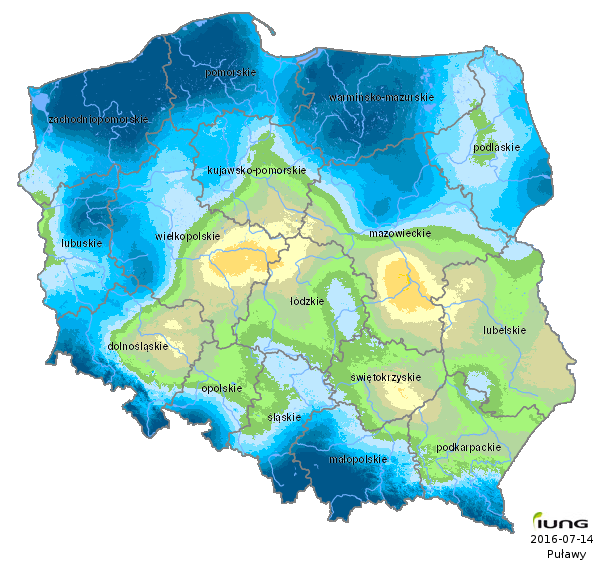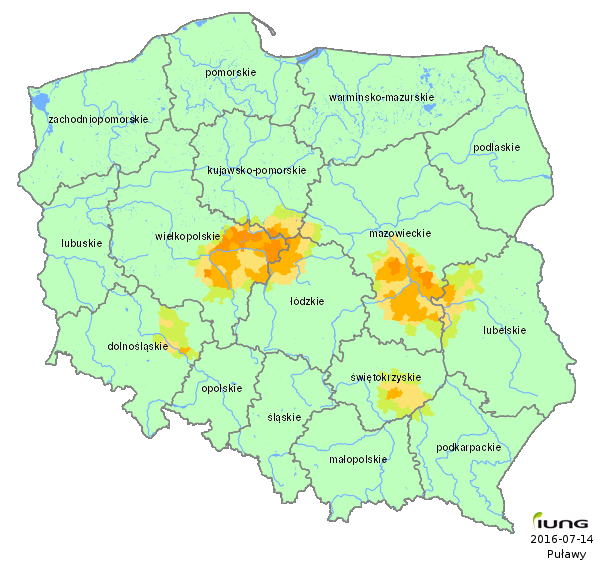ARCHIVES (2016)
Do roku 2016 raport oznaczony numerem 1 był tworzony za okres od 1 kwietnia do 31 maja. Od roku 2017 analizy są wykonywane o dekadę wcześniej czyli 1 raport oznacza okres od 21 marca do 20 maja
Communication report regarding the incidences of drought conditions in Poland
Year: 2016; period: 05 (11.V - 10.VII)
The Institute of Soil Science and Plant Cultivation – State Research Institute, in accordance with an Act from the Minister of Agriculture and Rural Development has developed the climatic water balance for all 2478 Polish local districts and, on the basis of soil categories, calculated the current risk of agricultural drought for the following crops: winter and spring cereals, grain maize and maize for silage, rape and turnip rape, potato, sugar beet, hops, tobacco, ground vegetables, fruit shrubs and trees, strawberries and legumes.
In the fifth reporting period, i.e. from May 11 to July 10, IUNG-PIB stated agricultural drought conditions in Poland. The Climatic Water Balance values, which are the basis for assessing the risk of agricultural drought, are negative for the majority of areas.
Agricultural drought in the current sixty-day period is less intense, affecting an area smaller than 10 days ago. The number of crops with yield reduced by 20% due to the drought in comparison to the yield obtained in average multiannual weather conditions has also decreased.
In the previous reporting period drought was stated for 6 crops. Currently it occurs only in rape, turnip rape and spring cereals.
In the previous reporting period drought occurred in 428 local districts (17.3% of all local districts in Poland), in 4.0% of arable lands in 10 voivodships.
In the current reporting period drought occurs in 242 local districts (9.8% of all local districts in Poland) in 2.5% of arable lands in 8 voivodships.
In comparison to the previous reporting period the number of local districts under the risk of drought has decreased by 186 (7.5 %), and the area of arable lands affected by drought has decreased by 1.5%.
In the current reporting period, from May 11 to July 10 the Climatic Water Balance values, which are the basis for assessing the risk of agricultural drought, are higher by approximately 17mm in comparison to the previous period.
Drought occurs only on soils of Category I (very light soils), granulometric groups:
•Loose sand
•Loose dusty sand
•Slightly loamy sand
•Slightly loamy dusty sand
As in the previous sixty-day period, so in the current one drought still occurs in rape and turnip rape. It was recorded in 8 voivodships in 242 local districts in Poland. In relation to the previous reporting period, the number of local districts under the risk of drought for these crops has increased by 218. Drought is currently stated in 9.77% local districts (8.8% more than in the previous period), in the area of 2.48% of arable land (2.39% more than in the previous period). Detailed data on drought occurrence in these crops in particular voivodships are presented in Table 1.
Table 1.
| No. | Voivodship | Number of local districts | Number of local districts at risk | Share of local districts at risk [%] | Share of the area at risk [%] |
|---|---|---|---|---|---|
| 1 | wielkopolskie | 226 | 66 | 29.20 | 9.20 |
| 2 | mazowieckie | 314 | 73 | 23.25 | 5.76 |
| 3 | świętokrzyskie | 102 | 22 | 21.57 | 2.50 |
| 4 | łódzkie | 177 | 23 | 12.99 | 4.35 |
| 5 | lubelskie | 213 | 26 | 12.21 | 1.49 |
| 6 | kujawsko-pomorskie | 144 | 15 | 10.42 | 2.27 |
| 7 | dolnośląskie | 169 | 12 | 7.10 | 0.93 |
| 8 | podkarpackie | 160 | 5 | 3.12 | 0.09 |
Agricultural drought still occurs in spring crops, noted in 5 voivodships in 100 local districts in Poland. In relation to the previous reporting period, the number of voivodships under the risk of drought had decreased by 5 (by 328 local districts). Drought occurs in 4.04% of all local districts in Poland (13.23% less that in the previous reporting period), in the area of 1.0% of arable land (3.04% less). Table 2 presents detailed data on drought occurrence for local districts and the area of arable land in particular voivodships.
Table 2.
| No. | Voivodship | Number of local districts | Number of local districts at risk | Share of local districts at risk [%] | Share of the area at risk [%] |
|---|---|---|---|---|---|
| 1 | wielkopolskie | 226 | 44 | 19.47 | 5.08 |
| 2 | mazowieckie | 314 | 43 | 13.69 | 2.91 |
| 3 | świętokrzyskie | 102 | 6 | 5.88 | 0.54 |
| 4 | łódzkie | 177 | 6 | 3.39 | 0.82 |
| 5 | lubelskie | 213 | 1 | 0.47 | 0.07 |
May was warm this year, particularly in Lubuska Land and here and there in the areas of Wielkopolska Lowland, Mazowiecka Lowland, Szczecińska Lowland and Kujawy, where the air temperature was above 15.5°C and was 2°C higher than the multiannual average. In the majority of the country the temperature recorded ranged from 14 to 15°C, and was 1-1.5°C higher than the multiannual average. The lowest temperature was in Sudety and Karpaty and in the north-eastern part of Słowińskie Coastland, ranging from 12 to 14°C, and exceeding the multiannual average by 1-1.5°C.
The first decade of June was characterised by a relatively high air temperature in the vast area of western Poland, and particularly in the north-western part of the country, ranging from 17 to 18.5°C, the further towards the east the lower being the temperature recorded. In the majority of eastern Poland the temperature of 15°C was recorded. In the second and third decade of June the situation was reversed. Definitely the warmest temperature was recorded in the south-east of Poland, ranging from 17.5 to 18.5°C in the second decade, and from 21.5 to 22.5°C in the third. In large areas of the country temperature ranging from 16 to 17.5°C was recorded in the second decade, and from 20 to 21.5°C in the third. In the northern regions it ranged from 14 to 16°C in the second and from 19 to 20°C in the third decade.
In the first decade of July air temperature was little diversified. Slightly lower temperatures were recorded in the northern parts of the country, ranging from 16 to 17.5°C. In the central and southern parts of Poland it was warmer, from 17.5 to 18.5°C.
In May the precipitation widely varied. The lowest, not exceeding 20 mm, was recorded in Lubuska Land and Szczecińska Lowland. It constituted ca. 30% of the multiannual average. Low precipitation occurred in many regions, such as: Wielkopolska Lowland, Silesia Lowland, Kujawy, in the southern part of Mazowiecka Lowland, in Małopolska Upland, Silesian Upland, Polesie, Kaszuby, Zachodnio- and Południowosuwalskie Lake Districts, and in Sandomierska Basin, where it ranged from 20 to 40 mm, constituting 40-60% of the norm. In the majority of the country precipitation ranged from 40 to 60 mm (60-80% of the norm). The highest was recorded in Sudeckie and Karpackie Forelands, from 60 to more than 120mm.
The wide range of precipitation in the country was a result of the stormy character of rainfall, which is why the areas with very high precipitation occurred right next to the low precipitation regions.
In the first decade of June precipitation was low in the vast area of the country. Particularly low precipitation, not exceeding 5 mm was recorded in the significant area of north-western Poland and in Lubelskie region. In the vast area of the country it ranged from 5 to 15 mm.
In the second decade of June, on the other hand, the greatest precipitation occurred in the north-western part of Poland, ranging from 20 to 60 mm, and in some regions even from 60 to 100 mm. Low precipitation, from 10 to 20 mm occurred in the vast majority of the country, and very low precipitation, not exceeding 10mm, was recorded in the south-eastern part of Poland.
In the third decade of June the greatest precipitation was recorded in two areas: one from Lubuska Land through the east of Pomeranian Lake District and the west of Mazurskie Lake District, and the other, between Silesian Upland, Małopolska Upland and Mazowiecka Lowland to Mazurskie Lake District. In these areas precipitation ranged from 20 to 60 mm, here and there exceeding 100 mm. In the rest of the country the precipitation was lower, from10 to 20 mm.
The first decade of July was characterised by very high precipitation ranging from 40 to more than 100mm in the north of Poland. In the north-east of the country it was lower, from 40 to 60 mm. In the majority of the country precipitation ranged from 10 to 40 mm.
As in the previous reporting period, so in the current one, there was a wide variety of water resources levels for arable crops in Poland. Water deficiency significantly decreased in the north, due to intense rainfall in that area. In other regions, where the water deficiency level was the highest, the situation has not changed. The greatest water deficiency, from-170 to -179mm, still occurs in Łaska and Turecka Uplands, but it is serious also in the southern regions of Mazowiecka Lowland, where it resulted in a considerable yield reduction. It mostly concerns crops located on weak and very weak soils.
Report prepared by:
Dr hab. Andrzej Doroszewski, prof. nadzw.
Dr hab. Rafał Pudełko
Mgr Piotr Koza
Mgr Elżbieta Wróblewska
Reports
- Report 13 (1.VIII - 30.IX)
- Report 12 (21.VII - 20.IX) +
- Report 11 (11.VII - 10.IX)
- Report 10 (1.VII - 31.VIII)
- Report 09 (21.VI - 20.VIII)
- Report 08 (11.VI - 10.VIII)
- Report 07 (1.VI - 31.VII)
- Report 06 (21.V - 20.VII)
- Report 05 (11.V - 10.VII) +
- Report 04 (1.V - 30.VI) +
- Report 03 (21.IV - 20.VI) +
- Report 02 (11.IV - 10.VI) +
- Report 01 (1.IV - 31.V) +





